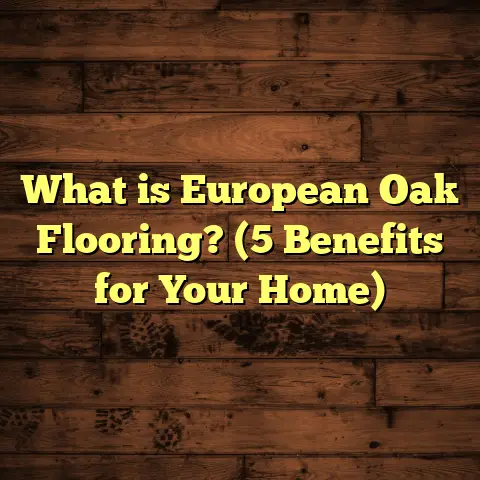What is a Floating Cork Floor? (5 Benefits for Eco-Friendly Homes)
Uniqueness is something I always appreciate when it comes to home design. Every space I work on has its own personality, and choosing the right flooring is a big part of that. Over the years, I’ve been involved in many flooring projects, from hardwood to tile, carpet, and vinyl. But floating cork floors? They’ve always stood out to me because of their natural feel and eco-friendly qualities. They’re not just floors; they bring a vibe that’s hard to match with other materials.
I remember one particular project in a family home where the owners were very environmentally conscious. They wanted something different—something that reflected their values but still offered comfort and durability. Floating cork flooring ended up being the perfect choice. It was soft underfoot, warm in winter, and had a natural texture that made the space feel alive and inviting.
If you’ve never heard about floating cork floors or you’re curious why they’re considered such a smart option for eco-friendly homes, stick with me. I’ll break down everything you need to know—from what floating cork floors are, how they’re made, why they’re great for green living, to how you can care for them and budget your project wisely.
What Is a Floating Cork Floor?
Let’s start with the basics: what exactly is a floating cork floor? The term “floating” refers to the method of installation where the floorboards or tiles are not nailed or glued directly to the subfloor. Instead, the pieces interlock with each other and rest on a layer beneath—usually an underlayment that provides cushioning and moisture protection.
The cork part comes from the bark of cork oak trees, which is harvested sustainably without cutting down the tree. This bark is processed into sheets or tiles used as flooring. The floating cork floor consists of several layers:
- Wear Layer: The top surface made from compressed cork granules with a protective finish.
- Core Layer: Usually high-density fiberboard (HDF) or plywood that provides stability.
- Underlayment: A cushioned layer underneath that helps with sound absorption and moisture resistance.
The unique cellular structure of cork gives these floors a soft, springy feel that’s unlike any other flooring type. Walking barefoot on cork feels like a gentle bounce beneath your feet—comforting and supportive.
How Floating Cork Floors Are Made
You might be curious about how cork transforms from tree bark into beautiful flooring material.
When cork oak bark is stripped (usually every 9-12 years), it goes through several steps:
- Boiling: The raw cork bark is boiled in water to clean it and make it more flexible.
- Flattening: After boiling, it’s pressed flat into large sheets.
- Granulation: These sheets are ground into granules of varying sizes.
- Compression: The granules are compressed under heat with natural resins to form dense blocks or panels.
- Cutting & Finishing: These blocks are sliced into planks or tiles and coated with finishes like polyurethane for durability.
This process keeps the natural properties of cork intact—its elasticity, breathability, and insulating qualities.
Why Floating Cork Floors Are Ideal for Eco-Friendly Homes
If sustainability drives your choices at home, floating cork floors have much to offer. Here are five reasons why I often recommend them for eco-friendly living:
1. Renewable Resource with Low Environmental Impact
Cork oak trees regenerate their bark naturally without harm, making cork an incredibly renewable material. According to the International Cork Association, about 100 million trees are currently managed sustainably worldwide.
What’s more, cork forests act as carbon sinks. They absorb CO2 not only during tree growth but also through their role in preventing desertification and preserving biodiversity.
The carbon footprint of cork production is relatively low compared to other flooring materials like vinyl or laminate, which rely heavily on petrochemicals.
2. Superior Thermal & Acoustic Insulation
One feature I always highlight during consultations is how cork’s cellular structure traps air in tiny pockets—this creates natural insulation against both temperature fluctuations and sound transmission.
In practical terms, this means your heating bills can drop because less heat escapes through your floors in winter. Similarly, noisy footsteps or voices don’t travel as much between floors.
In one apartment building I worked on, tenants reported significantly less noise disturbance after installing floating cork floors in their units—something that’s hard to achieve with harder surfaces like tile or hardwood.
3. Hypoallergenic Qualities
For families dealing with allergies or respiratory issues, flooring choice matters a lot. Cork floors don’t trap dust mites or pet dander the way carpets do.
Its natural antimicrobial properties prevent mold and mildew growth even in humid environments—a big plus for bathrooms and kitchens.
A client once told me switching from wall-to-wall carpet to floating cork floors helped their child’s asthma symptoms improve noticeably.
4. Easy Installation & Flexibility
Floating cork floors can be installed over various subfloors including concrete, plywood, or old vinyl. Because they don’t require glue or nails, installation is faster and less messy.
This method also makes floating cork an excellent choice for renters or homeowners who want temporary flooring solutions that can be removed without damage.
Using planning tools like FloorTally has helped me estimate installation time and costs more accurately for clients choosing floating cork floors—reducing surprises during budgeting.
5. Durability Paired with Comfort
One concern I often hear is whether cork can withstand heavy use. From my experience, yes—it holds up well if properly maintained.
Cork’s resilience means it can bounce back from minor dents and compression marks better than hardwoods which may crack or splinter under impact.
With protective finishes applied during manufacturing or added later through refinishing services, floating cork floors resist scratches and stains from everyday life.
Personal Stories From the Field
I want to share a few experiences that shaped my appreciation for floating cork floors.
Story 1: The Family That Loved Comfort
I installed floating cork flooring in a home where the parents were tired of cold hardwood floors that hurt their feet during morning routines.
They loved how soft the cork felt but were also concerned about durability because they had active kids and pets.
After two years, they told me they were thrilled with the choice. The floors remained beautiful and comfortable despite daily wear—plus quieter than before thanks to cork’s sound insulation.
Story 2: Eco-Conscious Renovation
Another memorable project was a couple renovating an older home aiming to reduce their environmental impact.
They wanted a green alternative to laminate but weren’t keen on carpet or vinyl due to chemicals and waste concerns.
Floating cork was perfect—not only sustainable but easy to install without adhesives that might emit VOCs.
Using FloorTally helped us align their budget with their green goals by providing clear estimates upfront—avoiding overspending on materials or labor.
Story 3: Allergy-Friendly Flooring
A family with allergy-prone kids switched from carpet to floating cork in bedrooms and playrooms.
They noticed less dust buildup and fewer allergy attacks within months—validating what research says about cork’s hypoallergenic nature.
Detailed Breakdown: Cork vs Other Flooring Types
Let’s compare floating cork floors with some popular options in terms of eco-friendliness, comfort, durability, and price.
| Flooring Type | Eco-Friendly Rating | Comfort Level | Durability | Average Cost per sq.ft | Installation Complexity |
|---|---|---|---|---|---|
| Floating Cork | High | Very High | Moderate-High | $4 – $8 | Easy |
| Hardwood | Moderate | Moderate | High | $6 – $12 | Moderate |
| Laminate | Low-Moderate | Low | Moderate | $2 – $5 | Easy |
| Vinyl | Low | Low | High | $2 – $7 | Easy |
| Carpet | Low | High | Low | $3 – $7 | Moderate |
Cork strikes a unique balance between natural material benefits and modern installation ease that many homeowners find appealing.
How I Use FloorTally in Planning Cork Floor Projects
Budgeting can be tricky when you want quality without surprises later. When I plan installations for clients choosing floating cork floors, FloorTally has become my go-to tool for cost estimation.
With FloorTally, I enter room dimensions, select material types (like specific cork products), add labor rates based on my region, and include waste factors that account for cutting errors or future repairs.
It consolidates all this info into clear cost breakdowns so clients see exactly where their money goes—from materials to labor and extras like baseboards or transitions.
This transparency builds trust and helps homeowners make informed decisions early on—not after unexpected bills arrive!
Installation Process Step-by-Step
If you ever consider installing floating cork floors yourself or want to understand what professionals do, here’s a quick overview:
- Prepare the Subfloor: Make sure it’s clean, flat, dry, and structurally sound.
- Lay Underlayment: This adds cushioning and moisture barrier properties.
- Acclimate Cork Planks: Let them sit in the room for 48 hours so they adjust to temperature/humidity.
- Start Laying Planks: Begin along one wall using the click-lock mechanism.
- Continue Row by Row: Stagger seams for stability and aesthetic appeal.
- Trim Edges: Cut planks as needed near walls.
- Install Molding/Trim: Cover expansion gaps around room edges.
- Clean & Inspect: Remove debris and check for gaps or misalignments.
Most DIYers can complete average rooms within a weekend if they follow instructions carefully.
Caring for Your Floating Cork Floor Over Time
Maintenance is straightforward but necessary if you want your floor looking great for years:
- Sweep frequently using soft bristle brooms.
- Use vacuum tools designed for hard floors.
- Mop occasionally with damp cloths; avoid soaking water.
- Place mats at entrances to reduce dirt tracked inside.
- Avoid harsh chemicals—stick to cleaners formulated for cork.
- Reapply finishes every 5-7 years depending on wear patterns.
Years ago I worked on an office where they neglected proper cleaning; within two years the floor looked dull with scratches. After professional refinishing and better maintenance routines, it looked almost new again.
Environmental Impact: Data & Research
I’ve reviewed multiple studies on flooring sustainability. Here are some highlights related to cork:
- The Life Cycle Assessment (LCA) by the European Cork Federation shows cork flooring emits up to 60% less greenhouse gases over its lifecycle compared to vinyl.
- Cork forests support biodiversity by providing habitats for endangered species like Iberian lynx.
- Cork flooring is biodegradable at end-of-life stages unlike synthetic alternatives which contribute to landfill waste.
- In Portugal alone, cork industry supports over 100,000 jobs while maintaining ecological balance.
These data points reaffirm why many eco-conscious builders specify cork when designing green homes or renovations.
Potential Drawbacks & How To Address Them
No product is perfect; floating cork floors also have some challenges:
- Water Sensitivity: Prolonged exposure can damage cork; avoid standing water.
- Fading: Direct sunlight may cause some discoloration over time.
- Indentations: Heavy furniture legs can leave marks unless protected by pads.
- Thickness Variability: Lower-end products may have thinner wear layers reducing lifespan.
To mitigate these:
- Use area rugs in sunny spots.
- Wipe spills immediately.
- Use protective furniture pads.
- Choose high-quality planks with thicker wear layers if budget permits.
Design Possibilities With Cork Flooring
Cork isn’t just functional; it’s versatile aesthetically too. Modern manufacturing allows various colors, patterns, and finishes:
- Natural tones ranging from light beige to deep brown.
- Patterns like herringbone or checkerboard formed by alternating planks.
- Painted or stained cork surfaces matching interior themes.
- Embossed textures mimicking wood grain or stone looks.
I once installed patterned floating cork floors that looked like reclaimed wood—a conversation starter every time guests visited!
FAQs About Floating Cork Floors
Q: Can floating cork floors be installed over radiant heating?
A: Yes! Cork’s thermal properties complement radiant heat well but make sure your product specs confirm compatibility.
Q: How long does floating cork flooring last?
A: With proper care, 15-25 years is typical depending on usage and finish quality.
Q: Are floating cork floors noisy underfoot?
A: Quite the opposite—they reduce noise due to their cushioning effect compared to hardwood or tile.
Q: Is floating installation better than glue-down for cork?
A: It depends on subfloor conditions; floating is easier and allows movement but glued-down can offer extra stability in some cases.
Q: Can I refinish a floating cork floor?
A: Some products allow sanding/refinishing if wear layers are thick enough; check manufacturer guidelines beforehand.
I hope this detailed guide helps you understand why floating cork floors are such a great choice—especially if you care about comfort, style, sustainability, and practicality all at once. Whether you’re renovating your home or just exploring flooring options, consider giving cork a try—you might be surprised how much difference it makes under your feet!
If you want advice tailored to your home or budget estimations based on local conditions, just ask—I’m happy to help guide you through the process.





